If you rock up to a downhill skate event, or simply flick through the pictures from one, you’ll see a lot of diversity, especially when it comes to the helmets people choose to wear.
From different shapes to different colors to unique designs and sizes. Riders choose to wear distinct pieces that fit their style, type of riding and color scheme.
In my article today, I’ll explain to you the difference between these designs and shapes. When you’re done reading it, you’ll be a tiny bit wiser and better placed to appreciate these unique works of art.
This article is part 4 of a 5 article series on skateboarding protection. Check out the other articles here:
- 11 essential & non-essential protective gear for downhill skating
- TSG DHP Knee Pads Review
- The 9 best and worst skateboarding helmets
- TSG Pass Helmet Review
The Types of Downhill Skate helmets
The half-shell helmet
These are the most common helmet you’ll come across. They are fairly standard and basic. They don’t cover your entire face but simply rest on your head -covering your hairline. With strap and buckle under your chin to keep it locked in.

Riders like these helmets because they are easy to wear and are non-intrusive. Once they have them on they can sort of even forget that they are there at all. They are usually lightweight and their open nature makes them great to wear in hot weather.
Under speeds of 30mph, they are the most appropriate helmet to have/wear. You’ll probably run into riders wearing them at freeride events, slide jams, or when they are just putting around on their local hill. You won’t really find them at most races or on most roads over 30-40mph.
Safety-wise, these helmets usually have their safety capabilities defined by the following certifications (i.e if your helmet doesn’t have any of the below, it’s not certified to protect you from impacts and you shouldn’t wear it):
- ASTM F1492
- CE (European)
- CSPC
You can find out more about these helmets by reading this article here.
Types of half-shell Helmets
The Classic half-shell
The most common half-shell you will find is this classic type. As mentioned earlier, it simply stretches across your hairline, covering only half of your face.
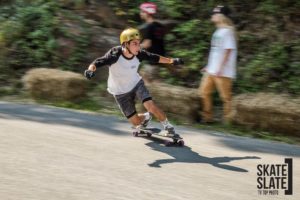
The “full-cut” half-shell
Borrowing from Snowboard style helmets. The full-cut half-shell helmet features ear coverings on it. They have no real performance benefit over their counterparts above, but they look pretty cool.

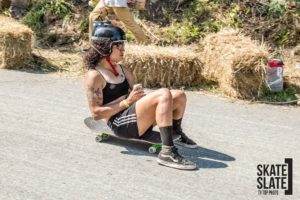
How much do they cost and where to get one?
These helmets typically cost between $20-50. Some more expensive and unique versions, like the helmets that use MIPS technology, can cost over $100, but that’s in an extreme case.
A decent helmet with adequate protection and quality will typically set you back around $40. With the half-cut options typically going for a bit more.
You can usually buy a helmet from your local skate shop. That or you can simply choose to buy one online, whichever works best for you and your needs. Some brands you’ll come across are S1, Triple 8, TSG, Protect, POC, to name a few.
For a good example of decent half-shell, take a look at the Triple 8 dual-certified Brainsaver here on Amazon.com. These type of helmets are my recommendation for beginners skaters – they are cheap, easy to use and provide adequate protection.
The ‘Basic’ full-face helmet
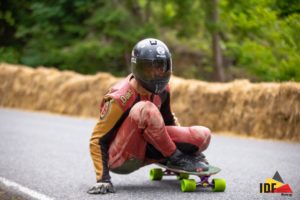
The full-face helmet is simply a helmet that covers the entirety of your face and head. So unlike the half-shell above, it features a chin bar and a visor (depending on the model).
The rider to the right choosing to wear an S1 full-face lifer.
These helmets are what you want once you start regularly breaking 40mph/70kph. this is because it’s hard to control what happens when you fall that fast – usually, riders can slide out a fall on their gloves, shoes and knee pads. But faster than 40mph, things can happen too quickly for you to be able to react appropriately. You simply want your face to be protected in case of anything.
The helmets also feature more EPS foam so they can better deal with those higher impact forces you can expect to get if you fall when going that fast.
The visors are also a welcome addition. They keep the wind, dust, cold, etc., from blinding you and bugs from (literally) smacking you in the face as you skate along – this has happened to me too many times to count. It is indescribable how annoying and frustrating it is to be bitch-slapped by a fly when you’re going 45mph.
The visors are typically removable, but this may vary from model to model.
The TSG Pass makes an appearance below. Matched to the riders green leathers.
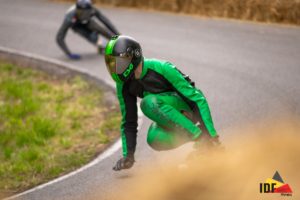
Finally, because of the amount of protection they provide, they are typically a requirement for most riders to wear at most race events (think IDF – international downhill federation events).
They typical certifications they have are:
- CPSC
- EN 1078
- ASTM F1952
- CE
Check out this list of helmets and their certifications from freerides.org. Check it out here. Thanks to Berry Plasman for the plug.
The above certification will vary depending on which helmet models you choose. However, the ASTM one is the most stringent and is the best certification to choose from if safety is a top concern. Check out the TSG Carbon Pass in the photo below.
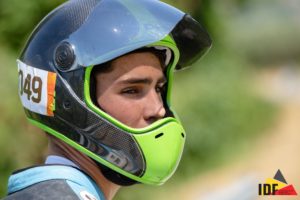
Types of full-face helmets
The “I’m broke, but well protected” mountain bike helmet
These helmets are what most beginners tend to go for. They are great because they are low cost and offer the exact same protection as the more expensive downhill dedicated helmets do – they have the CPSC, EN 1078 and ASTM F1952 certifications. They also typically cost around $60, whilst the dedicated downhill helmets cost upwards of $150.


But these helmets have not been purpose-built for downhill skating and it shows. Whilst our helmets have built-in visors, these just have visor-shaders – that whilst useful for downhill-mountain biking (for shading, preventing debris from hitting your face etc.), they don’t deal with things we have issues with (wind, noise, bugs – nothing a pair of glasses won’t fix). They also tend to not have as great visibility as the dedicated downhill skate helmets do.
But yes, in short, you can a buy a mountain biking helmet like the Bell Sanction, and be adequately protected for downhill skateboarding.
Check out this list of helmets and their certifications from freerides.org. Check it out here. Thanks to Berry Plasman for the plug.
To find out more about one, check out the Bell Sanction here on Amazon.com – a great and fairly decent helmet you can get.
The full-face helmet
Full faces come in different shapes, sizes, and designs.
These are used across downhill activities as a whole. You’ll find luge riders, rollerbladers, skeleton riders, gravity bikers, eskaters etc. using them.
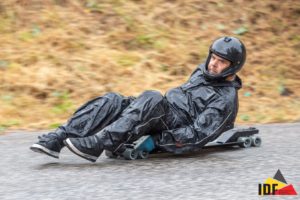
Some brands you will come across are Predator, S1, Triple 8 and TSG. The luge rider in the photo above is wearing a Predator helmet – choosing to use it without the visor (perhaps due to the rain?).

With these sort of helmets, you start to see riders customizing them. Take a look at Marc Escoda’s (@themarcscod) custom TSG Pass in the photo above. Jenny Schauerte (@jennyschauerte) in the photo below also has a pretty kickass custom design on her Predator DH-6.
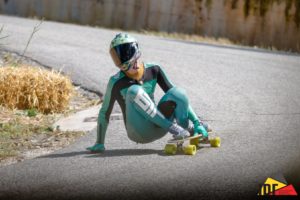
How much do they cost and where to buy one?
The price point for these usually hovers around $200. So whilst it will set you back a pretty penny, they aren’t soo out of reach for most wallets.
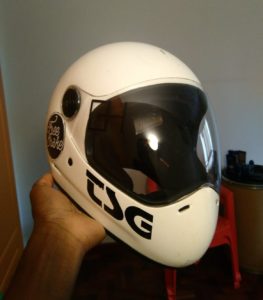 The good thing is that they aren’t one use. They typically have enough EPS foam that they can take a couple of hits before they need to be discarded or have to have their EPS foam replaced – but if you take a really heavy impact in them, you should give them their due and allow them to rest. It would be unwise to continue to use them as they won’t protect you well from other impacts.
The good thing is that they aren’t one use. They typically have enough EPS foam that they can take a couple of hits before they need to be discarded or have to have their EPS foam replaced – but if you take a really heavy impact in them, you should give them their due and allow them to rest. It would be unwise to continue to use them as they won’t protect you well from other impacts.
Some full-face helmets you can buy/check out are:
- TSG Pass – check it out here on Amazon.com (my suggestion for a great all-around helmet – it is what I personally use).
- Triple 8 racer
- S1 Lifer Full face
- Predator DH6
- New Olders helmets
- Risch helmets
It’s wise to get a full-face when you start going fast regularly. For E-skaters and the like, it might be best to get one from the get-go – you guys start going fast pretty quick (even beginners) and don’t have the reflexes (and experience) downhill skaters do with falling. You also don’t encounter the same problems – for example with heat build-up. I personally dislike using my full-face for regular sessions due to how hot and sweaty it can get in them, especially when I’m pushing around or walking up the hill – they aren’t much fun to take-off and carry too. But E-skaters don’t need to worry about that hehe.
Electric skateboarders should get full-face helmets as soon as they can.
The Aero Helmet – the one people customize the most
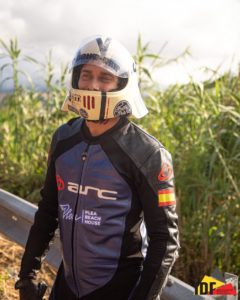
Aero-helmets are simply full-face helmets that have fairings that give them an ‘aerodynamic’ advantage. They fairings could be a tail at the base of the helmet extending over the back, or shoulder fairings that cover the shoulders. All this in an attempt to smooth out air moving over the head and body.
The idea for these came over from downhill skiers. They have unique helmets that have unique shapes. In fact, there is a healthy community of downhill skateboarding helmet collectors, buying old and unique downhill-skiing helmets for their collections, or simply repurposing them for downhill skating.
Imo, these helmets are more of a fashion statement than anything else – people customize them choosing different shapes and colors, really allowing their personalities and tastes to shine through. The performance advantage they provide is negligible.
But having said that, they do have a purpose and a solid idea behind their designs and shapes.
Mitch Thompson (@_mitch_thompson_) and Derek Blanquer (@derekblanquer) rocking their New Olders helmets.
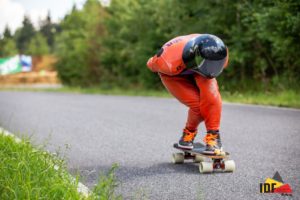
What do they do?
These helmets have been designed to be aero and give you an aerodynamic advantage. The reality is though, they don’t do much of that at all … but they look really cool so riders still wear them. I explain my thoughts on this and why I think so below.
They attempt to give you this aerodynamic advantage by creating a seamless transition between your head and the rest of your body. Take a look at the photo below for a really good example and illustration of this.
The rider is Pearse Darcy (@pearsedarcy), at the World Roller Games 2019 in Barcelona. Pic: Jeff Suchy (@godofbiscuits1).
The seamless transition hopes to create less drag by keeping the flow of air laminar and intact. If the laminar detaches and turns into drag, it will slow down our object (rider) that is moving through the air. Drag slows down objects moving through a fluid (air in this case) because it pushes against the object as it moves through the fluid. Laminar flow affects the objects less so is naturally more desirable.
A study of downhill skateboarding helmets in a wind tunnel found that the advantage they provide is little to negligible. In fact, when racing, they may even be less helpful. Because a rider tends to look back, lift their head to look around, etc., they may end up creating more drag through the fairings, slowing themselves down and giving other riders more of a chance to catch up. I think this effect may be amplified in the corners too.
Unless a rider keeps completely still, aerodynamic helmets, in my opinion, aren’t useful. That said, they may provide advantages on some tracks and are best suited for races like the L’Utime Descent top-speed challenge.
But with the above said, I am by no means an aerodynamics expert and may be entirely wrong. I also will 100% buy an aero helmet for myself one day even if they don’t have any advantages. Cause I mean, who doesn’t want to look THAT good coming down a hill?
Riders Nick Broms (@nick_broms) and Chase Hiller (@chasehiller96) rocking Vultur and New Olders Helmets respectively at the Kozakov Challenge 2019. Pic: Jeff Suchy (@godofbiscuits1).
How are they made?
These helmets are typically made from fiberglass or carbon fiber. Strips of carbon or fiberglass are laid against a premade mold and cured to fit the helmet shape. When removed from the mold, the front of the helmet is cut out to provide space for the visor and visor hinges. The helmet is then sanded down and painted accordingly. Lastly, it is fitted with EPS foam to provide safety and impact absorption for when you fall over and hit your head.
Disclaimer: I only have a rough idea of how these are made, so my description may not be entirely accurate.
Dexter Manning (@Dexmanning) rocks a custom made aero-helmet by Zak Maytum (@zak_maytum).

Where can you get one?
You can get some pre-made aero helmets from companies such as (and let me know if I should include any other companies on this list if I’ve missed any):
- Risch,
- New Olders,
- Boardyard,
- Vultur helmets,
- Team Mids.
New Olders has been proving itself to be a popular choice for many riders. They are based in South America and ship out their orders out to riders around the world.
Given this is such a niche industry. Most of these helmets are hand made and made to order. Though if you don’t want to wait, you can always get yourself a second-hand helmet.
The resale value on these helmets is pretty good. A lot of these helmets frequently change hands. In fact, some manufacturers like Risch and Boardyard aren’t really in ‘business’ anymore, but their helmets are still in demand across the market.
But yeah, you can choose to buy brand new from some companies like New Olders, or scour the second-hand market for something you would like. Some facebook groups like the AeroLid and Fullface Porn are good places to connect with people if you’re looking to buy a helmet for yourself.

Chase Hiller (@chasehiller96) and Tristan Cardillo (@aero_jimmy) wearing their custom painted New Olders Blackbirds.
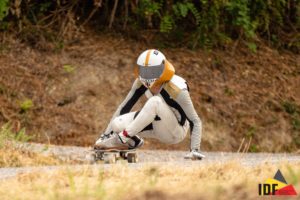
That said, some downhill skateboarders choose to make their own custom variations and designs of these helmets. Some choose to do it to create totally unique pieces for themselves, to simply have a helmet that fits better or just because it interests them. One thing is certain though, they do manage to make incredibly beautiful works of art.
Check out Aaron Hampshire (@a_swag211) wearing a custom helmet created by Zak Maytum (@zak_maytum).
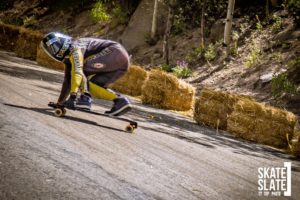
So, what’s the low-down on those custom Aero-helmets?
Most of them are custom made, with riders like Zak Maytum, Aaron Skippings, Max Capps, Kyle Martin, Stephen Vaast, Anders Inde, etc. making some sexy looking pieces out of carbon. These pieces are usually one-off or made in small batches. Because it’s a lot of work and not that rewarding (monetary wise – thanks to a small niche market), they tend to make a handful for themselves and their friends and might sell you one if they like you (or if the price is right).
Daina Banks (@daina_m0nstr) wears a custom Zak Maytum (@zak_maytum) helmet to match his unique leathers.
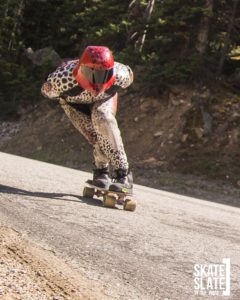
Check out some of the beautiful helmets composite specialist Stephan Vaast has created below. Being a composite specialist doesn’t hurt when it comes to making helmets. I personally think his helmets have some of the best finishes in the biz.
Another custom helmet maker to look at is Valahia Gear, based in Romania. Check out the photo below to see the killer aero lids coming out of their shop. The lid they made is on the left, the one on the right was made by none other than Mr. Kyle Martin himself – a legendary skater in his own right and a talented lid maker too. Both look pretty dope.
How much do Aero-helmets cost?
The more commercialized brands (like Risch, New Olders etc) have a typical price point between $200-400. Whilst they aren’t super expensive, they aren’t cheap either.
The custom options are usually more expensive and can sell from anywhere between $300 to $1000.
I’m unsure of the resale value of second-hand aero lids, but I’ve seen helmets on sale in BST groups, for prices between $150 to $300.
Oliver Moor (@Oliver_Moor) with custom painted Risch rosemary below

Are they safe?
There is a debate ongoing in the downhill community: Are these helmets safe or not?
The argument is this: The fairings on these helmets present a dilemma, a lot of people think they can ‘catch’ on the ground if you fall in a certain way. This could lead you to twist your head in an unnatural way that could lead to a serious injury.
But so far, I have not heard of an incident of a rider being seriously injured due to an aero lid (let me know if I’m wrong). However, just because it hasn’t happened, does not mean it’s not possible. And because of that, I think aero lids are best left to more experienced riders. Its definitely a territory beginners should think twice before stepping into -the potential for injury might be high and the equipment will neither be cheap or easy to replace if anything happens to it.
What do you think? Which helmet stands out the most to you?
Downhill skateboarding has a surprising amount of customization and ‘personal preference’ in almost every aspect of it. From the board you choose to ride, to the type of concave you like on it, From the grip tape you like best, to the footstop that feels most comfortable for you. And this goes on and on … from the wheels you choose because of rollspeed, durometer, color etc., to your choice trucks and hanger width.
In a way, all these options and choices can make settling on something a bit of a headache … but the flipside is that they provide the opportunity for the rewarding experience of choosing what you like, and the chance to build something that works best for you and your needs.
We are far better off with all these choices than we would be with only a handful.
And with that said, yeah, it is confusing learning about all these different helmets. And if you decide to get one for yourself in the future, you will be spoiled for choice. And that’s a good thing!
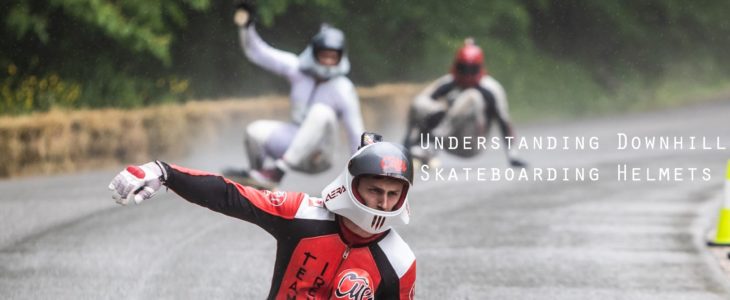
4 comments on “Understanding Downhill Skateboarding Helmets”
Veronica Delgado
November 4, 2020 at 11:50 pmHi, my name is Veronica, mu daughter is 16th and she is practicing downhill, it freaks me out to be honest, but I need to know what helmet I need to get for her, she is just starting but in Alicante the hills inspire respect. So please I need your help!!
AbugaA
November 12, 2020 at 2:54 amGet her a certified half shell helmet. A full-face will be more appropriate for speeds above 40mph. Sorry for the late response.
The ASTM F1492 and CE certifications are good.
Sharon
December 13, 2020 at 10:47 amHi, I’m just wondering how long do it take to have a custom downhill skateboard helmet made?
AbugaA
December 13, 2020 at 11:00 amIt can a while. Depends on the maker. Contact Aaron Skippins, Stephen Vaast or Kyle Martin. They should get back to you with the turn around time on their custom helmets